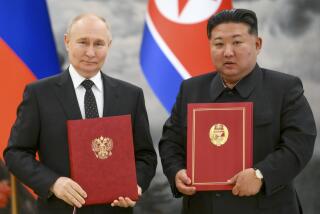‘The Partnership’ review: Cold warriors discuss nuclear disarmament
The Partnership
Five Cold Warriors and Their Quest to Ban the Bomb
Philip Taubman
Harper: 496 pp., $29.99
The op-ed article in the Wall Street Journal caught the nuclear world by surprise. Not for the argument it made but for who was making it.
The piece ran five years ago this month, under the headline “A World Free of Nuclear Weapons,” and was written by a remarkable bipartisan quartet of political figures: former secretaries of State Henry A. Kissinger(Nixon) and George Shultz (Reagan), defense expert and former Democratic Sen. Sam Nunn of Georgia and former Defense Secretary William Perry (Clinton).
Cold War veterans all, they argued that the world’s future security hung on whether the U.S., Russia and other nuclear powers could reduce their nuclear weapons stockpiles to zero. And they offered a road map for achieving that remarkable goal. But having a map and making a journey are two very different things — especially given the wild cards of North Korean and Iranian nuclear ambitions.
In his new book, “The Partnership: Five Cold Warriors and Their Quest to Ban the Bomb,” former New York Times journalist Philip Taubman traces the evolution of five former Cold War hawks into relative doves and follows their efforts to spur U.S. and Russian political leaders to dismantle stockpiles of nuclear weapons that make the Hiroshima bomb, despite its horrific power, seem like a minor explosion.
It’s an even-handed look at a convoluted history that is still unfolding. Taubman clearly believes the four former policy-makers, joined by respected Stanford physicist and nuclear expert Sidney Drell, are on the side of sanity. Yet Taubman, who also wrote “Secret Empire: Eisenhower, the CIA, and the Hidden Story of America’s Space Espionage,” carefully includes the arguments for maintaining nuclear capabilities, a theory based on deterrence.
That theory, even if once effective, no longer is workable more than 20 years after the collapse of the Soviet Union ended decades of nuclear stalemate, and accelerated fears that unsecured nuclear material could fall into the hands of terrorists — whose world view notably does not include the fear of mutually assured destruction that kept the U.S. and the USSR in check.
This is a complex book about complex subjects. Some of the key questions: How do you deter a first use by a stateless enemy who is not afraid of retaliation? How do the U.S. and Russia persuade other nuclear powers to mothball their arsenals without first — or simultaneously — shutting down their own? And after they’re eliminated, keep new arsenals from being assembled?
Despite the inherent complexities, Taubman does a clean job of reducing the elements to layman’s terms. He necessarily wanders a bit into the policy forest but never so deeply that he loses readers unversed in nuclear-weapons policy, which makes “The Partnership” a neat bit of book-length journalism rather than a narrative history.
One of the more interesting moments details PresidentReagan’s efforts to negotiate the elimination of nuclear weapons with Mikhail Gorbachev in their 1986 Reykjavik, Iceland, summit. Gorbachev was on the verge of making the historic agreement, but Reagan — who shared the goal — scuttled the deal by refusing to budge in his support for the much-ridiculed “Star Wars” defense system, the Strategic Defense Initiative missile shield. Had Reagan been willing to move, history could have been made, Taubman writes, though the U.S. Senate may not have ratified such a nuclear ban.
There has been some forward progress over the years. Most recently, the U.S. Senate ratified the “New START” nuclear arms reduction treaty with Russia in 2010, which reduced both nations’ operational strategic nuclear warheads from 2,200 each to 1,550 but left thousands more in reserve. Little other headway has been made despite President Obama’s support for a nuclear-free world.
Taubman had unparalleled access to the five men profiled here, including traveling with them to international gatherings. He also had permission to rummage around in some of their personal and previously unpublished files. It makes for intriguing reading and offers insights, especially, into Shultz and Kissinger and how former policy heavyweights can still command an international stage.
.
And Kissinger’s legendary ego comes into focus. As he signed on to the initial op-ed calling for an end to nuclear weapons he told friends that he doubted it could work, a two-track approach that would let him bask in the glow of success should the nuclear arsenals be dissolved, but also claim foresight should it crumble.
Taubman mentions in several places the ages of the five men, and it is a significant aspect of their efforts. Nunn, the youngest, is 73; the others are in their 80s. So the crucial work that could eliminate nuclear weapons probably will be left to a new generation.
And that may be the best hope, leaving the fate of the arsenals in the hands of people without direct memories of nuclear tests and civil defense drills, and without the Cold War-era presumptions about national ambitions. And against a contemporary backdrop of stateless terrorists, Indian-Pakistani tensions and the ambitions of North Korea and Iran, there is little time to lose.
Irvine-based writer Martelle is the author of “The Fear Within: Spies, Commies, and American Democracy on Trial.”
More to Read
The biggest entertainment stories
Get our big stories about Hollywood, film, television, music, arts, culture and more right in your inbox as soon as they publish.
You may occasionally receive promotional content from the Los Angeles Times.











